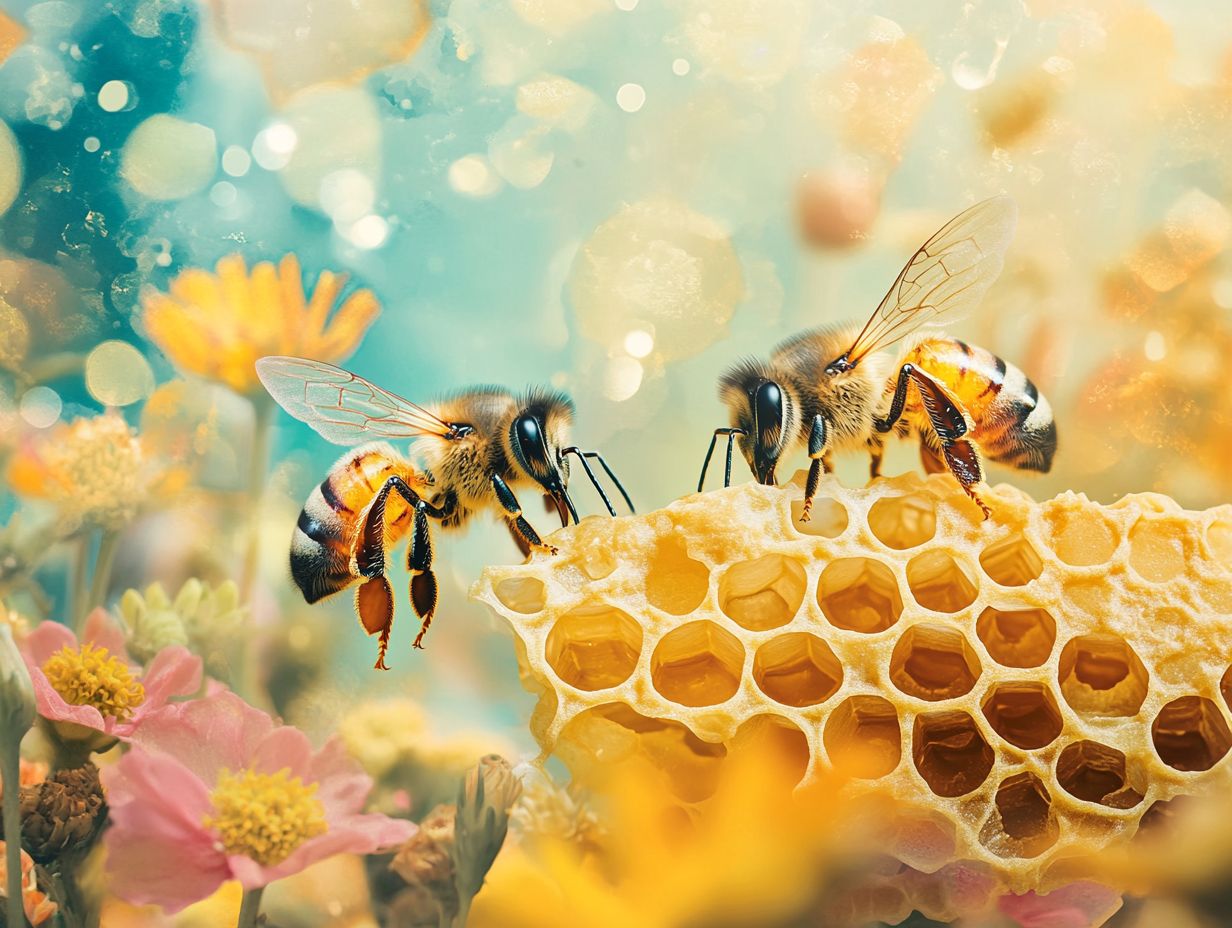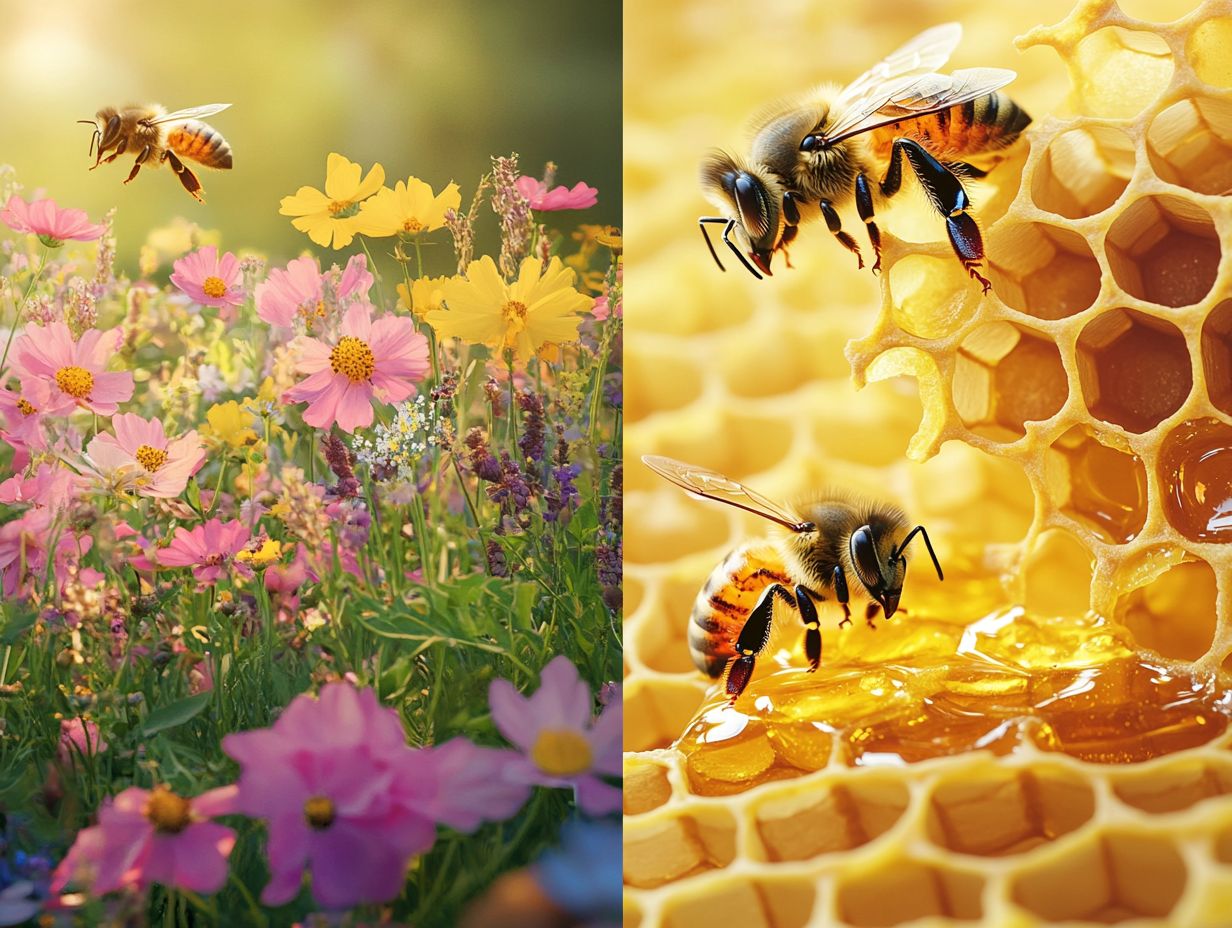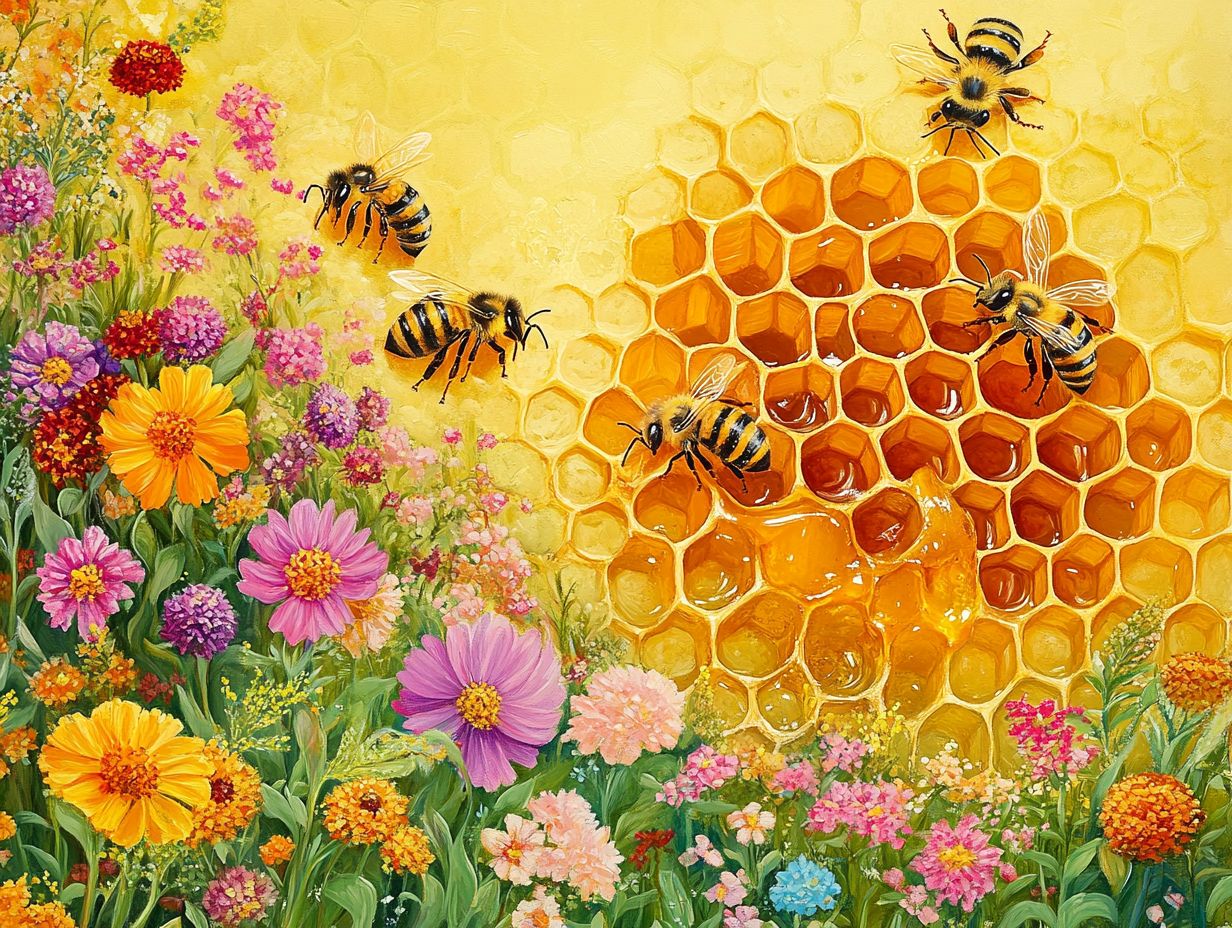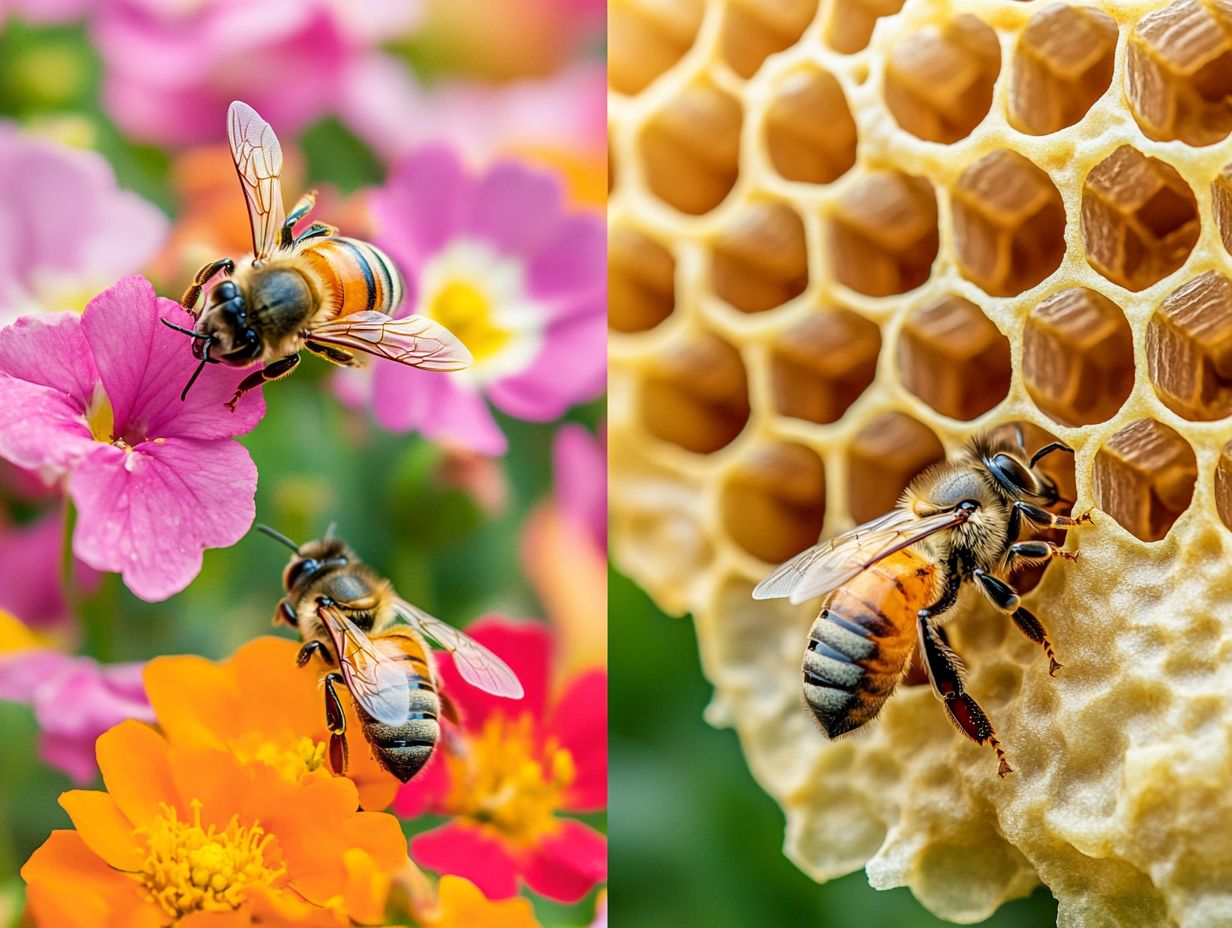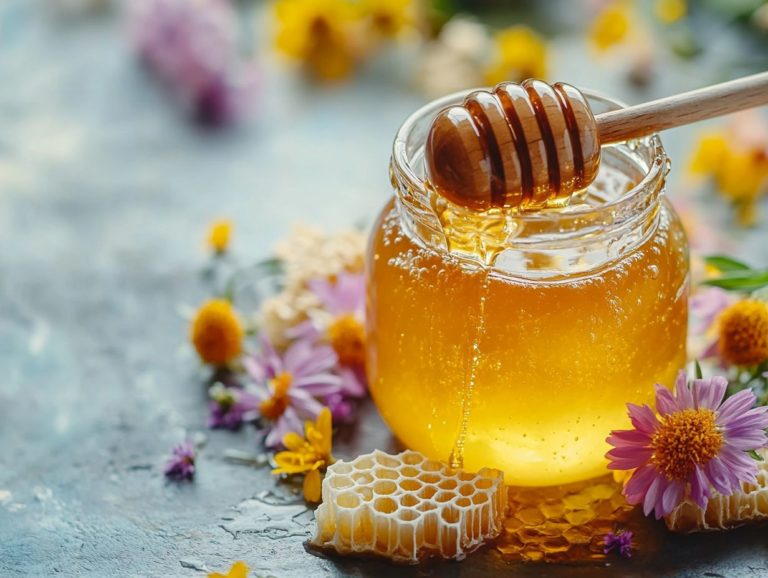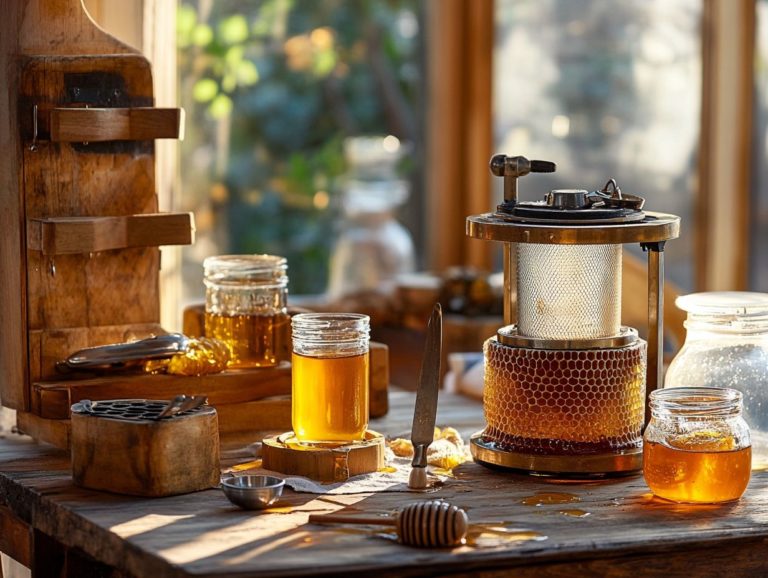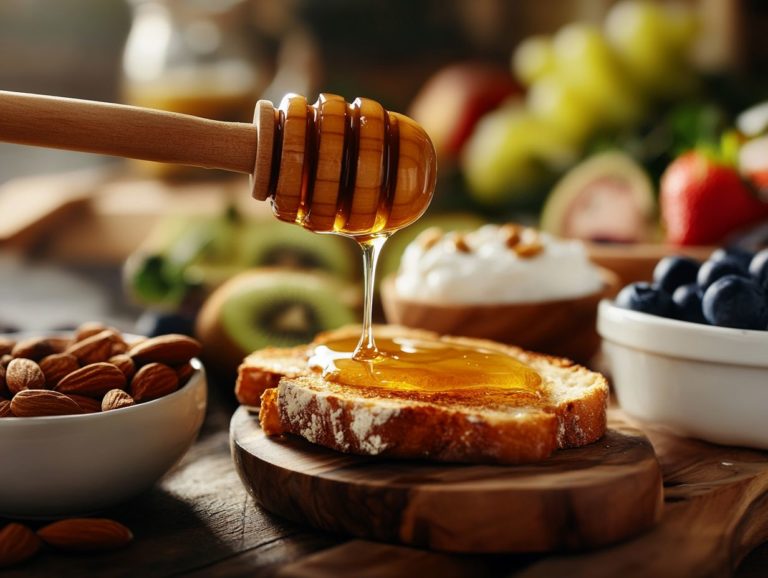The Role of Pollinators in Honey Production
Pollinators are the unsung heroes of honey production! They influence both the quantity and quality of honey. While bees often take center stage, fascinating creatures—like butterflies, bats, and certain birds—also play significant roles in this intricate process.
This exploration delves into how pollination works, the various types of bees involved, and the challenges these vital species face in today’s environment.
This section offers practical steps to support pollinators and promote sustainable honey production.
Discover the captivating world of pollinators and appreciate their indispensable contributions to the honey you cherish. Act now to protect pollinators, as their numbers are declining!
Contents
- Key Takeaways:
- How Do Pollinators Contribute to Honey Production?
- The Role of Bees in Honey Production
- Other Pollinators Involved in Honey Production
- Bats as Pollinators
- The Role of Birds in Pollination
- Other Insects in Pollination
- Threats to Pollinators and Honey Production
- Impact of Pesticides on Pollinators
- Ways to Support Pollinators and Promote Sustainable Honey Production
- Frequently Asked Questions
- What is the role of pollinators in honey production?
- Why are pollinators important for honey production?
- Which types of pollinators are involved in honey production?
- How do pollinators benefit from honey production?
- What are the potential consequences of a decline in pollinators for honey production?
- How can we support pollinators and ensure sustainable honey production?
Key Takeaways:
- Pollinators play a crucial role in honey production by pollinating flowers, which leads to the formation of honey.
- Bees are the primary pollinators, collecting nectar and converting it into honey through a complex process.
- To support pollinators and promote sustainable honey production, plant pollinator-friendly gardens, reduce pesticide use, and support local beekeepers.
How Do Pollinators Contribute to Honey Production?
Pollinators, especially honey bees, are essential for honey production. They facilitate the pollination process that boosts the yield and quality of many crops.
This intricate dance of nature significantly enhances agricultural output, allowing plants like sunflowers and almonds to flourish. These plants ultimately produce the nectar that honey bees eagerly collect.
The benefits of pollination extend beyond honey. This vital service underpins the health of our ecosystems and food security, creating a ripple effect that favors both beekeepers and consumers alike.
Pollination Process for Honey Production
The pollination process leading to honey production begins with honey bees visiting flowers to gather nectar and pollen, which they transport back to their hives.
As these industrious insects flit from bloom to bloom, they transfer pollen, which is vital for fertilization. This delightful interaction aids in the reproduction of flowering plants and significantly boosts crop production, making honey bees essential to agriculture.
A diverse array of flowers offers essential forage, supporting healthy ecosystems and ensuring the survival of these crucial pollinators. Effective pollination results in the production of seeds and fruits, illustrating the interconnectedness of flora and fauna in our environment.
How Do Pollinators Affect Honey Quality?
Pollinators play a crucial role in determining the quality of honey by directly influencing the floral diversity that honey bees depend on for nectar collection.
This diversity impacts the flavor and color of honey and enhances its nutritional benefits. When honey bees forage from many flowering plants, they gather nectar infused with unique compounds specific to those plants. Consequently, honey can vary dramatically in hue—from light to dark—and flavor—from mildly sweet to intensely robust—each batch telling a distinct story about its local environment.
Moreover, the health of honey bees is linked to the presence of diverse plant species. These bees require a well-balanced diet rich in nutrients to flourish. This relationship highlights the significance of environmental health; preserving diverse floral sources is essential for producing quality honey and maintaining the overall vitality of honey bee populations.
The Role of Bees in Honey Production
Bees, particularly honey bees, hold an essential role in honey production. Their efficient pollination services are crucial for the reproductive success of flowering plants, making them essential to the ecosystem and our food supply.
Join us in protecting these amazing creatures!
Types of Bees Used in Honey Production
The primary bee you’ll encounter in honey production is the honey bee, part of the Apis genus. These bees are celebrated for their remarkable foraging skills and intricate social structure.
The world of bees boasts incredible diversity, with various species each playing a unique role in our ecosystem. Take bumblebees, for example; these fuzzy pollinators are not just charming but also enhance the yields of fruits and vegetables through their diligent pollen collection.
Then there are solitary bees, like mason bees, which emerge early in spring, well before honey bees. This makes them essential during the crucial early blooming season.
Your partnership with beekeepers and these vibrant bee populations is essential. Beekeepers nurture the health and growth of these species, ensuring that healthy colonies thrive.
Supporting strong bee populations secures a flourishing honey market and fosters biodiversity and ecosystem stability. This underscores the critical importance of conservation efforts.
How Do Bees Collect Nectar and Pollen?
Bees collect nectar and pollen through remarkable foraging behavior, visiting various flowering plants to maximize their resource intake. These industrious pollinators rely on their strong sense of smell to locate blooms that emit enticing floral scents as they embark on this quest for food.
Upon discovering a suitable flower, they deftly navigate to its nectar-rich depths using their specialized mouthparts, which help them drink nectar. This process is crucial for the hive’s health since the nectar provides essential sugars that fuel the bees’ energy needs.
Pollen also plays a vital role in their diet, supplying the protein and nutrients necessary for brood development. This intricate foraging behavior not only ensures the colony’s survival but also supports the broader ecosystem by facilitating plant reproduction and enhancing biodiversity.
How Do Bees Convert Nectar into Honey?
Watch as bees perform their incredible magic by converting nectar into honey. This captivating process involves adding enzymes, evaporating moisture, and storing the sweet result in honeycomb cells.
As you delve into this fascinating transformation, imagine honey bees diligently collecting nectar from blossoms and transporting it back to their hive in their stomachs. Once they return, the nectar begins its metamorphosis, aided by specific enzymes like amylase, which break down complex sugars into simpler forms.
This enzymatic activity not only changes the nectar’s chemical makeup but also lowers its moisture content. To assist in this process, the bees fan their wings to create airflow that helps evaporate even more moisture.
This crucial reduction in water content directly influences the final quality of the honey, affecting its taste, texture, and shelf-life. Ultimately, this culminates in the rich, golden substance you savor.
Other Pollinators Involved in Honey Production
Alongside honey bees, you’ll find a diverse array of other pollinators, such as butterflies, moths, bats, and birds. Each plays a vital role in the intricate processes of pollination essential for honey production.
Butterflies and Moths
Butterflies and moths play an essential role in pollination by sipping nectar from a wide variety of flowering plants. This behavior nurtures diverse ecosystems and supports the reproductive processes of many plant species, transferring pollen as they dance from bloom to bloom.
You might notice that different species have their own favorites when it comes to plants, often drawn to specific colors and scents. These preferences can vary based on their natural habitats.
Areas brimming with wildflowers and rich vegetation not only provide the resources these pollinators need but also establish a balanced environment crucial for their life cycles.
In this intricate dance between flora and fauna, butterflies and moths not only enhance biodiversity but also contribute significantly to the overall health of the ecosystems they inhabit.
Bats as Pollinators
Bats aren’t just mysterious night creatures; they’re crucial for our environment! Bats serve as essential nighttime pollinators, primarily feeding on nectar while playing a critical role in the reproduction of numerous night-blooming plant species.
Their contributions are especially crucial for plants like agave, which is pivotal in tequila production, and the saguaro cactus. Both depend heavily on bats for effective pollination. As these remarkable creatures flit from flower to flower, they unwittingly transfer pollen while sipping nectar, nurturing biodiversity within their ecosystems.
However, habitat loss driven by urbanization and agricultural expansion presents a significant threat to their populations and, by extension, the plants they support. Protecting these habitats is vital, not just for the survival of bats but also for the flourishing of various flora that rely on them for reproduction.
The Role of Birds in Pollination
Certain bird species, like hummingbirds, play a crucial role as pollinators, feeding on nectar and facilitating the reproduction of a variety of flowering plants.
You’ll find these avian pollinators particularly attracted to brightly colored, tubular flowers, which are perfectly designed to accommodate their long bills and specialized feeding habits. While hummingbirds mainly gravitate towards red, orange, and pink blooms, other species such as sunbirds and honeycreepers share a similar affinity for specific colors.
By engaging in this vital interaction, these birds not only secure their own food sources but also enhance genetic diversity among plants. They transfer pollen from one bloom to another, promoting stability and resilience within ecosystems. This intricate relationship between birds and flowering plants is essential for maintaining biodiversity, influencing food webs, and supporting numerous other species within their habitats.
Other Insects in Pollination
Beyond bees, a fascinating array of insects, including beetles and flies, each play a vital role in pollination. These creatures contribute significantly to the biodiversity and health of ecosystems.
As you explore the interactions between these insects and flowering plants, you’ll discover unique relationships that ensure effective cross-pollination. For instance, beetles—often overlooked—are among the earliest pollinators, visiting various blooms and playing a crucial role in the reproductive cycles of many species. Meanwhile, flies are particularly attracted to flowers that emit strong scents, showcasing the intricate adaptations plants develop to lure in a diverse range of pollinators.
Keeping this diverse insect life thriving is crucial for a healthy ecosystem! It serves as a reminder of the interconnectedness that sustains life on Earth, urging you to appreciate the delicate balance that exists within nature.
Threats to Pollinators and Honey Production
Pollinators encounter a myriad of threats that profoundly affect honey production. Pesticides wield harmful effects, while habitat loss driven by urbanization further exacerbates the situation.
Climate change brings challenges that make survival harder for these essential creatures.
Impact of Pesticides on Pollinators
The use of pesticides in agricultural practices presents significant concerns for the health and longevity of pollinators. These harmful chemicals can severely harm vital pollinators, disrupting their life cycles.
Specifically, certain pesticides, like a type of pesticide harmful to bees, impair cognitive functions, diminish reproductive success, and alter foraging behavior, ultimately contributing to population declines. The presence of these toxins can also contaminate honey production, posing risks not only to the bees but also to you as a consumer.
As these crucial insects encounter increasing threats from pesticide exposure, the ripple effects extend throughout ecosystems, jeopardizing the very crops that depend on their pollination services. By understanding these dynamics, you can appreciate the critical role of pollinators in maintaining agricultural health and biodiversity.
Let’s work together to protect our pollinators and ensure a vibrant ecosystem for the future!
Habitat Loss and Fragmentation
Habitat loss and fragmentation, largely fueled by agricultural expansion and urban development, pose significant threats to pollinator populations and overall biodiversity. These environmental shifts disrupt the ecosystems that support vital species like bees and butterflies.
As natural habitats dwindle, food sources and nesting sites decline. This results in reduced pollinator populations. It’s vital for you, as a community member or agricultural stakeholder, to recognize the importance of preserving these natural environments.
By embracing sustainable agricultural practices—like crop rotation and reducing pesticide use—you can create spaces that promote pollinator health and boost your crop productivity.
Ultimately, safeguarding these habitats ensures a flourishing ecosystem, benefiting both agriculture and the wider environment.
Climate Change
Climate change presents a formidable challenge to pollinators by transforming their habitats and impacting food availability.
As temperatures rise and weather patterns become unpredictable, the delicate timing of plant blooming cycles is disrupted. This misalignment reduces food supply for essential creatures that depend on specific plants for survival.
Habitat degradation driven by urbanization also undermines the environments where these critical insects thrive. These ecological shifts can have severe repercussions for honey production, as beekeepers struggle to maintain healthy colonies amid dwindling resources.
Understanding these dynamics is essential for conservation efforts aimed at protecting pollinators and supporting the agricultural systems that rely on them.
Ways to Support Pollinators and Promote Sustainable Honey Production
To support pollinators and foster sustainable honey production, you and your community can adopt various strategies to enhance pollinator habitats and safeguard their well-being.
Planting Pollinator-friendly Gardens
Planting pollinator-friendly gardens is a superb way to support these vital creatures by providing a diverse array of native plants that offer nourishment throughout the growing season.
Consider incorporating a variety of flowering plants that bloom at different times to ensure a continuous food supply. Adding coneflowers, black-eyed Susans, and milkweed attracts bees and butterflies while enriching your local ecosystem.
Designing your space with clusters of these plants will enhance visibility for pollinators, making it easier for them to find resources. Including fragrant herbs like lavender and mint provides delightful aromas and encourages beneficial insects.
Creating layers of greenery—by combining ground covers, shrubs, and taller flowering plants—will enhance habitat complexity, inviting a diverse array of pollinators to thrive in your garden.
Reducing Pesticide Use
Reducing pesticide use is essential for protecting pollinators, as many chemicals can harm their health and overall populations. This need has sparked interest in safe alternatives that protect these crucial creatures while promoting sustainable agricultural and gardening practices.
Using integrated pest management—a method that combines different strategies to control pests—can significantly reduce pesticide application while still effectively managing pest populations. You might consider opting for organic solutions, such as introducing beneficial insects or using natural repellents from plants.
Creating diverse planting schemes that provide nectar and habitat, along with timing applications to avoid peak pollinator activity, can further reduce risks. Together, these strategies help foster an ecosystem where pollinators can thrive, ultimately enhancing food production and biodiversity.
Supporting Local Beekeepers
Supporting local beekeepers is vital for healthy pollinator populations and sustainable honey production. You can play a significant role by purchasing honey from nearby apiaries, which boosts local economies and reduces carbon emissions.
Join workshops to learn about bees and beekeeping! These experiences can deepen your understanding and inspire others to get involved.
Advocate for policies that protect pollinator habitats and promote organic farming. This step helps secure a thriving future for bees.
Conserving Natural Habitats
Conserving natural habitats is crucial for sustaining pollinator populations and maintaining biodiversity. These ecosystems, like wildflower meadows and forests, provide food and nesting sites for bees, butterflies, and bats.
If these habitats disappear, pollinators will decline, impacting countless plant species. This disruption affects entire food webs.
Help reverse these trends by creating pollinator gardens and preserving native plants. Collaborative efforts among communities can establish safe foraging and breeding grounds for these invaluable species.
Frequently Asked Questions
What is the role of pollinators in honey production?
Pollinators transfer pollen between plants, leading to flower fertilization and nectar production for bees to make honey. Without them, honey production would suffer.
Why are pollinators important for honey production?
Pollinators are essential for honey production because without them, plants would not produce fruits and seeds, including the nectar that bees need to make honey. This means that without pollinators, there would be no honey.
Which types of pollinators are involved in honey production?
Bees are the most well-known pollinators involved in honey production, but other insects such as butterflies, moths, and beetles also play a role. Additionally, birds, bats, and some mammals can act as pollinators.
How do pollinators benefit from honey production?
Pollinators benefit from honey production as they rely on the nectar and pollen from flowers to survive. The nectar provides them with energy, while the pollen is a vital source of protein. Honey production helps maintain healthy pollinator populations, ensuring their continued pollination services.
What are the potential consequences of a decline in pollinators for honey production?
A decline in pollinators could have severe consequences for honey production as it would lead to fewer plants producing nectar, resulting in less honey. This could ripple through agriculture, as many crops rely on pollination to produce fruits and seeds.
How can we support pollinators and ensure sustainable honey production?
We can support pollinators and ensure sustainable honey production by creating pollinator-friendly habitats, reducing pesticide use, and planting a diverse range of flowering plants. Support local beekeepers by buying locally produced honey to help maintain healthy pollinator populations and sustainable honey production.

